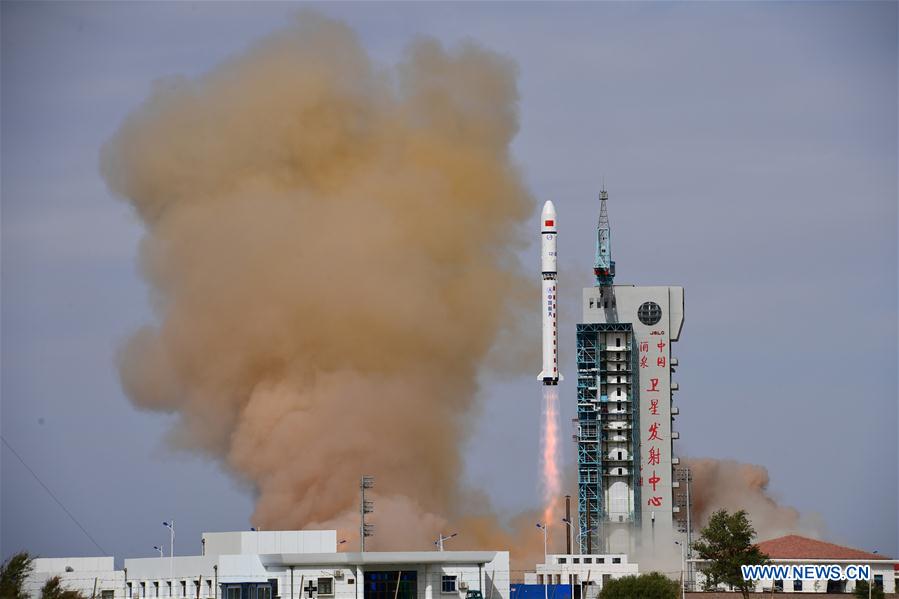


Two satellites carried by a Long March-2D carrier rocket are launched from the Jiuquan Satellite Launch Center, Northwest China's Gansu province, May 31, 2020. [Photo/Xinhua]
Designers have begun to develop an upgraded version of the Long March 11 carrier rocket called the Long March 11A, which they said will be wider and taller than the current model and have greater thrust.
A Long March 11 was launched from the Xichang Satellite Launch Center in Sichuan province for the first time on Saturday, sending two technology demonstration satellites into orbit.
China Aerospace Science and Technology Corp said the solid-propellant rocket blasted off at 4:13 am from the Xichang center, marking the 332nd flight of the Long March series.
The mission also marked the first use of a 2-meter-diameter fairing on a Long March 11 and the first use of a new rocket launch vehicle, it said.
Designed and built by the China Academy of Launch Vehicle Technology, the Long March 11 is the first and only solid-fuel rocket in the Long March family, the pillar of China's space programs.
It is 20.8 meters long, has a diameter of 2 meters and a liftoff weight of 58 metric tons. It is capable of sending satellites to low-Earth orbit or sun-synchronous orbit, the academy said.
Its first flight was in September 2015 from the Jiuquan Satellite Launch Center in the Gobi Desert.
Its nine launches have also included a seaborne mission from the Yellow Sea in June last year that was China's first sea-based space launch. It has successfully placed 39 satellites in orbit in those nine missions.
The new Long March 11A will be able to send 1.5 tons of payload to a sun-synchronous orbit at an altitude of 700 kilometers, nearly four times the Long March 11's capacity to that orbit, designers said.
The new model's design work will be finished before the end of this year, and it is expected to make its maiden flight around 2022, said Jin Xin, deputy project manager of Long March 11 series.
The two satellites lifted into orbit on Saturday were developed by the Chinese Academy of Sciences' Innovation Academy for Microsatellites in Shanghai and the National University of Defense Technology in Changsha, Hunan province. They will conduct intersatellite data link and Earth observation tests, the company said, adding that the Long March 11 will make several more flights from land-based launch centers and its sea-launch platform this year.
Saturday's flight was the first launch of a solid-propellant rocket mission from the Xichang center.
Dong Chongqing, Party chief of the center, said the mission showed Xichang has made strides in its rapid or emergency launch capabilities and that will strengthen its role in disaster-relief and emergency-response efforts.
The center has carried out more than 150 launches since 1984 and is now capable of launching more than 10 Long March rocket models.
Dong said Xichang is the most used of the country's four launch bases and the best in terms of launch capability.

 Award-winning photos show poverty reduction achievements in NE China's Jilin province
Award-winning photos show poverty reduction achievements in NE China's Jilin province People dance to greet advent of New Year in Ameiqituo Town, Guizhou
People dance to greet advent of New Year in Ameiqituo Town, Guizhou Fire brigade in Shanghai holds group wedding
Fire brigade in Shanghai holds group wedding Tourists enjoy ice sculptures in Datan Town, north China
Tourists enjoy ice sculptures in Datan Town, north China Sunset scenery of Dayan Pagoda in Xi'an
Sunset scenery of Dayan Pagoda in Xi'an Tourists have fun at scenic spot in Nanlong Town, NW China
Tourists have fun at scenic spot in Nanlong Town, NW China Harbin attracts tourists by making best use of ice in winter
Harbin attracts tourists by making best use of ice in winter In pics: FIS Alpine Ski Women's World Cup Slalom
In pics: FIS Alpine Ski Women's World Cup Slalom Black-necked cranes rest at reservoir in Lhunzhub County, Lhasa
Black-necked cranes rest at reservoir in Lhunzhub County, Lhasa China's FAST telescope will be available to foreign scientists in April
China's FAST telescope will be available to foreign scientists in April